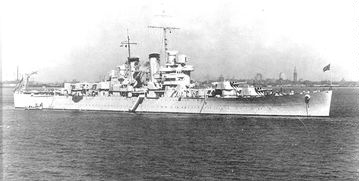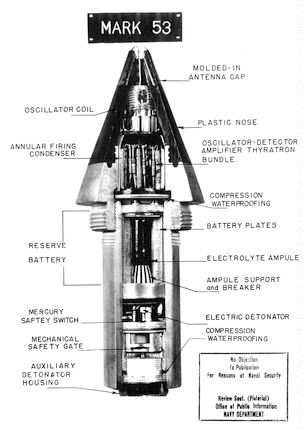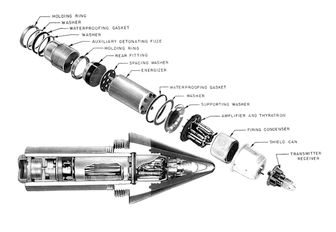Three critical secret projects were pivotal for the Allied victory in WW2. Two of these were the development of the atomic bomb and radar. The third was the development of the proximity or VT (Variable Time) fuze.
Prior to the war two types of fuzes were used: the timed fuze was set to explode at a predetermined time after firing and the contact fuze, used in smaller caliber weapons, exploded on contact with an object. Neither was effective against the highly maneuverable airplanes that had been developed since the end of the First World War. The British began the development of a projectile which would automatically detonate in close proximity to the target in 1939 and the American effort began in early 1940.
The US Navy was particularly concerned with the vulnerability of surface ships to aircraft attack. It was clear that the problem of fleet protection demanded a drastically more effective means of destroying enemy air power than either the timed or contact fuze provided.
Section T of the Applied Physics Laboratory at Johns Hopkins University, under the direction of Dr. Merle A. Tuve, was assigned the task of developing and overseeing the production of a proximity type of fuze for the Navy's 5" guns which were their primary long-range anti-aircraft weapon. The theory was simplicity itself: The fuze would contain a miniature radio transmitter-receiver which would send out a signal. When the signal reflected back from the target reached a certain frequency, caused by the proximity of the target, a circuit in the fuze closed firing a small charge in the base of the fuze that detonate the projectile.
The theory may have been simple, but the problems encountered in all steps of development and after the fuze was released for use by the fleet were formidable. Consider, that the components in the fuze, including tiny glass vacuum tubes, had to withstand the shock of being fired from a 5" gun. This set back force of 20,000 g's is instantly generated by accelerating the projectile to a 2,800 foot per second muzzle velocity. In addition, the shell's brief trip through the gun's rifling grooves starts it spinning at 25,000 revolutions per minute. Safety features had to be built in to protect the men handling the ammunition in transit and aboard ship. Additional safety features were necessary to prevent the shell from exploding too soon after firing which would endanger the gun crews and nearby ships. A self-destruct feature was also necessary to prevent dud fuzes from falling into the hands of the enemy. Moisture was an ongoing problem that had to be dealt with and there were many other problems that are too numerous to mention here.
The Crosley Corporation was one of five companies that assembled proximity fuzes. A total of eighty-seven different firms using one hundred ten factories were engaged in some phase of production work. Crosley's involvement began in late October 1941 when they were contacted by the Bureau of Ordnance and told that they would be contacted later that month concerning a "top secret, top priority" project. Lewis M. Clement, Crosley's vice-president in charge of Engineering, recalled that Crosley had been selected because they had the required background in electrical and mechanical engineering and in mass production. The letter of intent from the Navy came in late November 1941 and a contract for 500 fuzes in December. The first accepted fuzes came from the production line in September 1942. On January 5,1943 Lt. "Red" Cochrane, commanding the aft 5" battery on the light cruiser Helena, shot down a Japanese Val dive-bomber with the second of three salvos of VT-fuzed shells, near Guadalcanal. The fuzes were manufactured by the Crosley Corporation and this was the first kill of enemy aircraft.
Although primarily a supplier to the Navy for use in the Pacific and the Mediterranean theaters, Crosley fuzes were used with great success by the British against the V-1 buzz bomb, by the U.S. Army on the European continent in the defense of Antwerp against V-1 attacks and in the Battle of the Bulge.
In a post war interview, Lewis Crosley said that fuze production reached sixteen thousand five hundred units per day. The Crosley Corporation employed ten thousand people and worked around the clock, seven days a week. Mr. Crosley said, "We enlarged until . . . we were the largest employer and produced more than anybody in Cincinnati, including any of the other big companies located in Cincinnati at that time. We had some very, very secret and wonderful products that we produced in volume for the Armed Forces and we got a lot of credit for doing it." Bureau of Ordnance figures show that Crosley produced 5,205,913, or 24%, of the slightly more than twenty-two million proximity fuzes manufactured during the war.
The importance of the proximity fuze to the successful outcome of the Second World War is best stated by those who witnessed it's effectiveness.
James V. Forrestal, Secretary of the Navy said, "The proximity fuze has helped blaze the trail to Japan. Without the protection this ingenious device has given the surface ships of the Fleet, our westward push could not have been so swift and the cost in men and ships would have been immeasurably greater."
Prime Minister, Winston S. Churchill was quoted with "These so-called proximity fuzes, made in the United States.., proved potent against the small unmanned aircraft (V-1) with which we were assailed in 1944."
And Commanding General of the Third Army, George S. Patton said, "The funny fuze won the Battle of the Bulge for us. I think that when all armies get this shell we will have to devise some new method of warfare."
This article originally appeared on the Crosley Automobile Club Inc. website. It is republished here with the kind permission of of the author, Ed Jennings.
All rights reserved. No part of this article may be reproduced, stored in a retrieval system or transmitted in any form or by any means, electronic, mechanical, photocopying, recording or otherwise without the prior permission of the author.
The following tables adapted from information given in "Naval Weapons of World War Two" by John Campbell show the USN's anti-aircraft successes between October 1944 and January 1945:
| Weapon | Planes Shot Down | Number of rounds per plane |
|---|---|---|
| 5"/38 using AA Common | 19 | 1,162 |
| 5"/38 using VT | 24.5 | 310 |
| 3"/50 using AA Common | 6.5 | 710 |
| 40 mm Bofors | 114 | 2,272 |
| 1.1" MG | 1 | 2,231 |
| 20 mm Oerlikon | 62.5 | 8,972 |
| 0.5" MG | 2.5 | 28,069 |
Generally speaking, Kamikaze actions were at very close range with the aircraft closing fast upon their intended target. These sort of engagements were very difficult for weapons firing time-fuzed ammunition, as the rate of change in the ballistic range to the aircraft also meant that the fuze settings needed to have large changes from one round to the next. Any lag or delay in getting a particular round into the air after its fuze had been set meant that its detonation would be too far away to reach the target aircraft. The VT fuze eliminated that problem, as noted by its far smaller rounds per aircraft rate.
| Weapon | Planes Shot Down | Number of rounds per plane |
|---|---|---|
| 5"/38 using AA Common | 33.5 | 960 |
| 5"/38 using VT | 20 | 624 |
| 3"/50 using AA Common | 4 | 752 |
| 40 mm Bofors | 46 | 3,361 |
| 1.1" MG | 0 | (4,764 total) |
| 20 mm Oerlikon | 50.5 | 7,152 |
| 0.5" MG | 3 | 15,139 |
In this table the advantage of the VT fuze, while still significant, is not nearly so pronounced as in the previous table. This may be due to the fact that the rate of change of the attacking aircraft's ballistic range did not change as rapidly as did a Kamikaze aircraft, thus allowing the fire control computers more time to process the incoming data and produce better time fuze settings. It is interesting to study the success rate of the 3"/50 gun, as this weapon was adapted post-war with automatic loading and VT fuzes to replace the 40 mm Bofors on most US warships. Even without VT fuzes, the shoot-down rate of the smaller weapon compares favorably to that of the 5"/38 firing VT-fuzed ordnance. Although, the high numbers for the 5"/38 may be a result of the fast firing rates of these weapons and the fact that nearly every warship destroyer-size and larger carried several of these weapons. So, even a pair of destroyers could fire over 200 rounds per minute.
For more information on the VT fuze, see the Ralph Baldwin book, "The Deadly Fuze - Secret Weapon of World War II." An analysis in this book of the 278 aircraft shot down by VT fuzed projectiles between October 1944 and August 1945 indicates that only 46 of these would have been destroyed if time fuzed projectiles had been employed. However, Will Jurens, noted ordnance authority, estimates that Baldwin's 6:1 ratio apparently assumes that 70% of the VT fuzes worked. A 50% failure rate - the Navy's lower limit of acceptability - meant the effectiveness ratio was closer to 4:1. In comparison, mechanical time fuzes such as the Mk 18 typically worked about 90%-95% of the time.
Some time after the above essay was written, I exchanged a few messages with a gentleman who is the Chief Scientist of the Center for Naval Analyses. In the interests of clarity and completeness, I have combined and paraphrased his comments to make the following addendum.
These data in Campbell's "Naval Weapons of World War Two" appear to be taken (and stripped of context) from some earlier work by the Operations Research Group (ORG) relating to the Philippines campaign. Speaking as the Chief Scientist of the Center for Naval Analyses, the direct descendant of ORG, I will tell you that I believe that the figures below represent a sounder methodology applied to a better data set. That said, however, I would not bet the farm on any of these numbers.
There are a lot of pitfalls in this sort of analysis, and it is extremely difficult to arrive at meaningful numbers. With this caveat firmly in mind, I will quote some of the better figures for World War II:
Type of Attack Planes Shot Down Rounds per Plane 20 mm 40 mm 5"/38 MT1 5"/38 VT Kamikaze 24 27,200 6,000 1,000 200 Non-Kamikaze 41 30,100 4,500 1,000 550 These figures are from the Special Defense Operations Research Group (SpecORG) study, "AA Defense of the Fast Carrier Task Force - 24 October 1944 To 21 March 1945", Anti-Aircraft Study No. 8, revised 11 September 1945. They address only carrier task groups, for which the best data were available.
Another SpecORG study, AA Study 13 of 12 October 1945, "Anti-Aircraft Actions in the Okinawa Campaign, 18 March - 15 August 1945", estimated that on average the Japanese lost 3 to 10 times as many aircraft per ship damaged or destroyed in non-suicide attacks as were required in suicide attacks.
- ^MT = Mechanical Timer (i.e., Time Fuzed AA Common)
01 February 2001 - Updated
06 May 2024 - Converted to HTML 5 format
19 February 2025 - Fixed formatting problem




